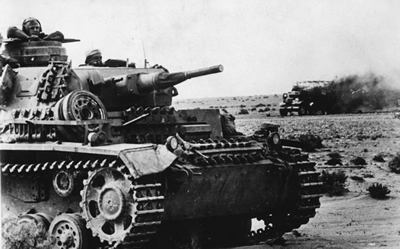During the Battle of Alam el Halfa, which took place in North Africa during World War II, Rommel attempted to regain El Alamein in Egypt; eventually, however, he was forced to retreat.
The Battle of Alam el Halfa (sometimes known as the Battle of Alam Halfa)  lasted from August 30 to September 5, 1941.
lasted from August 30 to September 5, 1941.
After the First Battle of El Alamein, which ended in a draw, more tanks were supplied to both sides.
The number of Allied tanks was increased to 935. Some of these were new American Sherman tanks. The British also had Mark IV Churchills and M3 General Grants.
Axis forces now had 440 tanks – 200 of these were reinforcements and the rest were vehicles that had been repaired.
100 of the new panzers (77 Panzer IIIs and 23 Panzer IVs) had long guns. This increased their firing range and made armor penetration easier.
Rommel also received infantry reinforcements, and with his forces replenished, he decided to break through British positions from the south, where the British infantry was weak and there were not many anti-tank guns.
In fact, Montgomery had wished to entice Rommel into this action.
On August 30, 1942 Rommel ordered his Afrika Korps to move east and south of Egypt’s Alam el Halfa Ridge.
The Afrika Korps were then supposed to swing north to the Mediterranean coast and encircle the British Eighth Army.
Things did not go smoothly for Rommel. The panzers had difficulty moving in the soft, desert sand. Rommel had underestimated the amount of land mines in the area.
In addition, British Intelligence had already informed Montgomery of Rommel’s plans. The RAF bombarded the German tanks. The Seventh Armoured Division, which had been, placed south of Alam el Halfa Ridge, harassed the Axis forces.
The 10th Armoured Division and the 22nd Armoured Brigade were positioned at the ridge.
As ordered by Montgomery, British tanks did not advance forward, but remained dug in their positions, defending against the German advance.
On the evening of August 31, Rommel’s tanks arrived at Alam el Halfa.
Although Rommel was not fully prepared to attack the stronger British forces in the north, he realized that he had no choice. He had to swing north and attack the British tanks and guns where they were most powerful.
At first, the panzers were able to break into British positions, as the British Grant tanks were unable to use their main guns when the hulls were down.
However, an armored counterattack resulted in heavy casualties for the Germans.
The British then went on the offensive. Eventually, the Germans were forced to flee, leaving some their panzers on the battlefield to be recovered by the British.
By September 5, the Germans had returned to their original positions west of El Alamein.